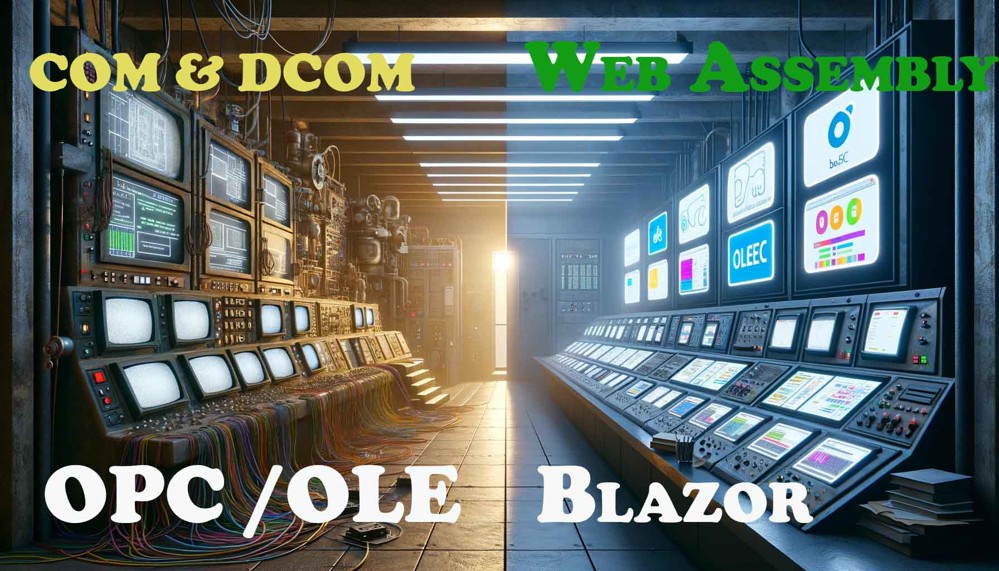Navigating the Transition: From OLE/OPC to .NET 8 and WebAssembly in Industrial Process Control

In the realm of industrial process control, the evolution of technology platforms is both inevitable and essential. Traditionally, Object Linking and Embedding (OLE) for Process Control (OPC) has been the backbone for facilitating communication between various hardware and software components within industrial systems. However, the relentless march of technology beckons a shift towards more modern, robust, and flexible solutions. Enter the era of .NET 8, Blazor apps, and WebAssembly, which promise to redefine the landscape of industrial process control systems. This article delves into the reasons behind the necessity for this transition, alongside a balanced examination of the benefits and potential drawbacks of making such a switch.
The Catalysts for Change: Limitations of OLE/OPC
OLE/OPC has served the industry well, providing a standard interface for exchanging data between devices and applications in industrial environments. Despite its widespread adoption and proven track record, several inherent limitations have emerged:
- Complexity and Interoperability Issues: OLE/OPC relies heavily on COM/DCOM technologies, which can be complex to configure and troubleshoot, especially in distributed environments.
- Security Concerns: As cyber threats evolve, the security mechanisms of older OLE/OPC standards struggle to meet modern cybersecurity demands.
- Scalability and Performance: High-performance, real-time processing demands can outstrip the capabilities of OLE/OPC-based systems, especially in large-scale or highly distributed environments.
The Promise of .NET 8, Blazor, and WebAssembly
The introduction of .NET 8 and Blazor, especially when combined with the power of WebAssembly, presents a compelling alternative to traditional OLE/OPC-based systems. These technologies offer several advantages that directly address the limitations of the old guard.
Enhanced Security and Reliability
.NET 8 brings to the table advanced security features and a managed runtime environment that significantly reduces the risk of memory leaks and other vulnerabilities that can plague traditional industrial applications. This is crucial in process control systems where security and reliability are non-negotiable.
Unprecedented Performance and Scalability
Blazor and WebAssembly enable the execution of .NET code directly in the browser at near-native speed. This capability, coupled with the performance optimizations in .NET 8, allows for the development of highly responsive and scalable process control applications that can manage the demands of modern industrial operations.
Simplified Development and Maintenance
With Blazor, developers can use C# and .NET to build both client and server parts of an application, streamlining the development process. This uniformity significantly reduces the complexity and cost associated with maintaining and upgrading process control systems over time.
Evaluating the Transition: Benefits and Demerits
Benefits of Switching from OLE/OPC to .NET 8 and WebAssembly
- Cross-Platform Compatibility: .NET 8 applications can run on any platform (Windows, Linux, macOS), offering greater flexibility than the traditionally Windows-centric OLE/OPC.
- Real-Time Data Processing: Blazor and WebAssembly facilitate real-time data processing and visualization in the browser, enhancing the responsiveness of control systems.
- Future-Proofing: Adopting .NET 8 and WebAssembly positions industrial systems to easily integrate with future technologies and standards.
Potential Drawbacks
- Transition Costs: Migrating from OLE/OPC to a .NET 8/Blazor/WebAssembly-based system involves upfront costs, including retraining staff and potentially rewriting existing applications.
- Maturity and Ecosystem Support: While rapidly maturing, the ecosystem around Blazor and WebAssembly is not as established as OLE/OPC, potentially leading to challenges in finding support and resources.
- Performance Considerations: Although WebAssembly offers near-native performance, the most resource-constrained environments might still face challenges until the technology and optimization techniques mature further.
The Path Forward
The transition from OLE/OPC to .NET 8, Blazor, and WebAssembly in industrial process control is not merely a technological upgrade but a strategic realignment towards more secure, scalable, and future-ready systems. While the benefits of making this switch are clear, it is essential to approach the transition with a strategic plan that considers the potential challenges and costs involved.
Strategic Planning and Phased Implementation
A phased approach, starting with pilot projects to gauge the effectiveness and iron out any issues before a full-scale rollout, can mitigate risks. Additionally, investing in training and choosing the right partners for the transition can ease the process.
Leveraging the Community and Ecosystem
The vibrant .NET community and the growing ecosystem around Blazor and WebAssembly offer a wealth of resources, tools, and support for organizations making the transition. Engaging with this community can provide valuable insights and assistance.
Conclusion
The shift from OLE/OPC to .NET 8, Blazor, and WebAssembly represents a significant step forward for industrial process control. This transition opens up new possibilities for enhancing performance, security, and scalability while addressing the inherent limitations of traditional technologies. By carefully considering the benefits and potential challenges, organizations can navigate this transition effectively, ensuring that their process control systems are robust, flexible, and prepared for the challenges of the future.


